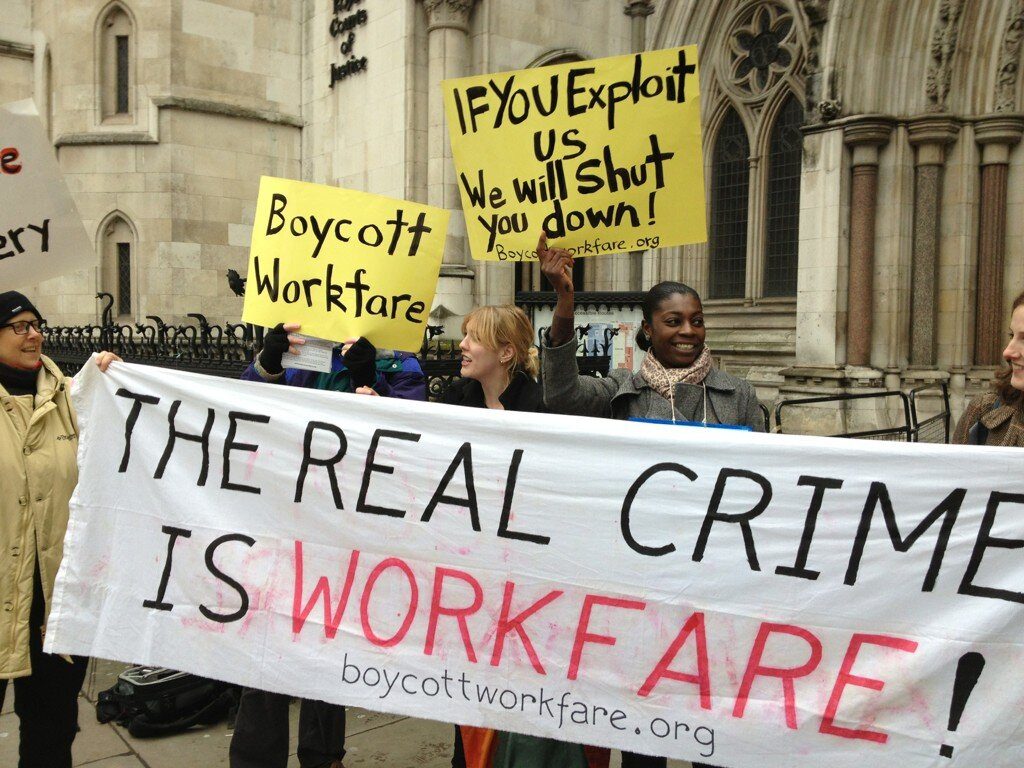In the last few weeks, a workfare proposal going under the general heading of “job guarantee” got picked up by Kirsten Gillibrand, Cory Booker, and Bernie Sanders. Advocates of the new workfare have done a lot to pitch the program as bold and unprecedented and this has ended up scrambling a lot of pundit and journalist responses because they have no referent for how to even begin to understand it.
But the idea of conditioning receipt of welfare benefits (in this case unemployment allowance) on work is not remotely new. It goes back at least to the 19th century workhouses operated under the British poor laws. The term “workfare” was coined by civil rights leader Charles Evers in the 1960s. Indeed some of the newest crop of workfare advocates operating under the “job guarantee” label source their inspiration directly from these civil rights forerunners. Despite nods to this legacy, the advocates of the new workfare nonetheless distance from the term, most likely because the last time we did workfare in this country was on the heels of the 1996 welfare reform, which the left now regards as a cruel failure.
Distancing from the last bout of workfare we had makes sense as a political strategy, but if you want to start talking about what workfare actually looks like in practice, the prior models are an obvious place to start. In particular, the prior models help to answer the question that most advocates are very vague about: what kind of work can you realistically have the benefit recipients do? What kind of work checks off all the boxes of low-skill, temporary, able to go unfilled, low-capital, and non-competitive with existing jobs?
There are plenty of countries one could look at to see how this works. Probably the best current example of this in the world is Work For The Dole in Australia. An enterprising outlet looking to put some flesh on this would be wise to send a reporter over there or at least hire a local one. But we don’t have to go across the world because we’ve done workfare already right here at home, with the biggest implementation of workfare coming just a few years ago in the biggest city in the country:
Back in 1998, then-Mayor Rudolph W. Giuliani announced that every adult or head of household still on the rolls in the year 2000 would be working for a welfare check. He hired Jason Turner, then-Wisconsin Gov. Tommy Thompson’s welfare administrator, to accomplish this task for New York City. In an attempt to achieve the mayor’s goal, Turner created the largest workfare program in the country.
Assessing the success of the Giuliani workfare program is tough in part because it is hard to figure out what workfare is even for. As the Times noted in 1998, workfare programs invariably wind up being justified on three separate bases that are somewhat at odds with one another:
There is no agreement on whether workfare ”works,” because there is no agreement on what it is supposed to do. Giuliani himself alternates between three quite different rationales. One is simply to cut the caseloads. (”The most impressive number is 460,000 fewer people now dependent.”) A second is to prepare people for regular, wage-paying jobs. (”The best way out of poverty. . .is working your way out of it.”) And a third is to construct a new social-contract that emphasizes everyone’s obligations to contribute. (”In life, you have to give back.”)
All three are at play in the current workfare push as well. Advocates argue that the new workfare will cut other welfare payments such as SNAP, EITC, TANF, Medicaid, and CHIP. They argue that it will provide training and skills that can be used when benefit recipients move into real work. And then they argue that the work done in the workfare program is its own justification, that it gives people a chance to contribute. Meet the new workfare, same as the old workfare.
The biggest rhetorical difference between the old workfare and the new workfare is that the latter justification — that the workfare job is a good in its own right — is getting more emphasis than the TANF workfare programs. But this emphasis then doubly raises the question of what are these jobs actually going to be like? What does actually fit all the constraints of workfare?
When you look at the people who have actually had to confront this question on the ground, the answer has been kind of what you would expect: menial tasks that are not terribly pleasant. NYC workfare recipients were made to clean public restrooms, pick up dead animals, and pick up trash in public parks. Some also did low-level office work. Notably Bill de Blasio, in response to pressure from critics, promised to kill this program when he was elected and, as of 2016, was working to replace the workfare jobs with “job training, high-school equivalency classes and college studies.”
Real workfare jobs are a far cry from the kinds of jobs many advocates seem to think could be done in the new workfare program. Despite claims to the contrary, you will not be building bridges out of a job guarantee office. You will not be doing child care out of a job guarantee office. You will not be staffing ambulances out of a job guarantee office. All of these tasks require either high levels of skill, large amounts of capital, or permanence of service, none of which meet the constraints that a workfare program has to deal with.

